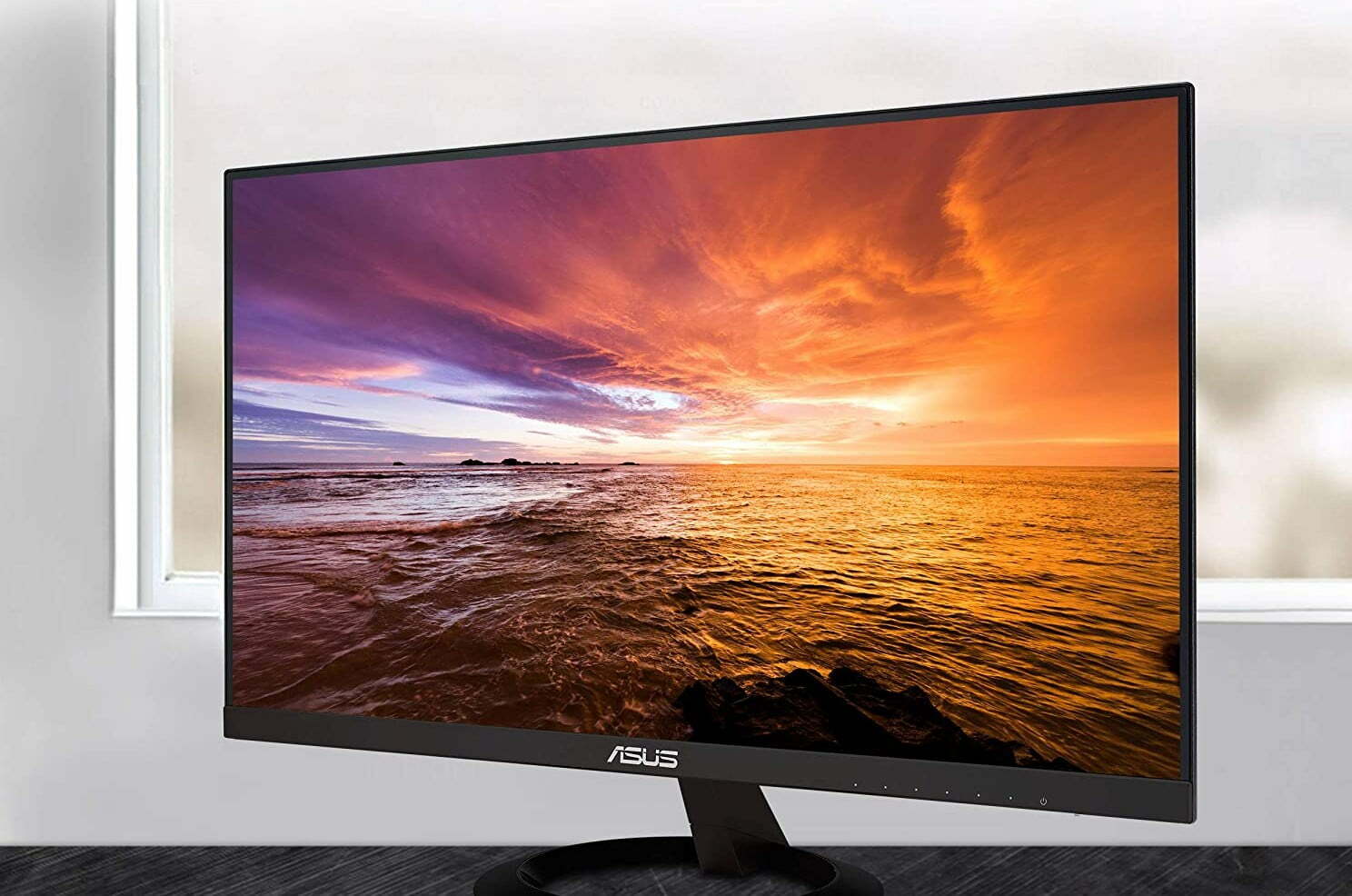Key Takeaways:
- Contrast ratio is the difference between the brightest image a display or monitor can create and the darkest
- Dynamic Contrast Ratio numbers in displays can be used in confusing or misleading ways
- Native contrast ratio is what a display is capable of as opposed to what an additional image processing chip is capable of
Defining dynamic contrast ratio requires first explaining what native contrast ratio is. Multiple factors come into play when it comes to the maximum image quality a display or monitor is capable of, but contrast ratio – or simply put, the difference between the brightest and darkest image a display is capable of- is probably the most important, as well as the most misunderstood. By the way, we recommend knowing how a monitor works overall as well while you’re learning about individual monitor settings.
Dynamic Contrast Ratio is a term used by many manufacturers without a strict standard, which can make it confusing to consumers and can be used in sometimes misleading ways to make products stand out in the market. Below, we’ll discuss what DCR means and how understanding it can help you choose the best possible fit for your high-performing computer monitor setup.
Related Post:
What Is Dynamic Contrast Ratio?
Unlike a monitor color accuracy test, the Contrast Ratio (CR) in monitors refers to the ratio of luminance between the brightest white and darkest black the display is capable of producing and is expressed numerically as brightest white: darkest black, so in a monitor whose brightest white is, for example, 1000 times brighter than its darkest black, it would be written as 1000:1- which is, incidentally, considered an excellent CR in a consumer display or a top HDR monitor.
Dynamic Contrast (DC), sometimes also called advanced dynamic contrast ratio (ACR), refers to a setting in DC-supported displays that lessens the power of the backlight lamp while proportionately amplifying the overall transmission through the LCD panel whenever it needs to display dark images, theoretically creating darker blacks than possible with DC disengaged.
The downside is that if the dark image has small portions of super bright light, the overall image will be overexposed. To compensate, the display will try to determine an acceptable degree to which the super bright portions will be blown out with being noticeable to the viewer. Displays with DC functionality generally contain a dedicated processing chip to handle these calculations, and as a rule, are generally LCD displays. You can manually maintain the color accuracy on your display if you learn how to calibrate a monitor.
Dynamic Contrast Ratio in Marketing
One issue for consumers when choosing a display with DC functionality is that it’s now fairly typical for manufacturers to market and describe their monitors listing only their DC numbers and not their native contrast ratio. This can be deceptive because while that number is often higher than the native contrast ratio, a monitor with a higher native contrast ratio will still offer superior overall contrast to a display with a lower native CR but a high DC. Therefore it’s a good idea to always try to find out what the display’s native CR numbers are, and never to compare one display’s DC number to another’s CR number.
STAT:
Contrast Ratio and Dynamic Contrast Ratio are both numerically expressed as brightest white: darkest black- a CR of 1000:1 means that the display’s brightest white is 1000 times brighter than its darkest black.
https://www.konicaminolta.com/instruments/products/display/color-analyzer/ca210/index.html
Dynamic Contrast Ratio numbers are often used in marketing because they create the impression of better contrast performance than may be actually available in a display.
https://www.intel.com/content/www/us/en/gaming/resources/everything-you-need-to-know-about-gaming-monitors.html
Dynamic Contrast Ratio capabilities in monitors require a backlit design and a dedicated processing chip in addition to a display’s native capabilities and are generally LCD models.
Sources:
http://phrogz.net/tmp/ScreenDensityCalculator.html#find:density,pxW:1920,pxH:720,size:12.3,sizeUnit:in,axis:diag,distance:31,distUnit:in
https://www.rtings.com/monitor/tests/picture-quality/contrast-ratio#:~:text=The%20contrast%20ratio%20is%20the,difference%20in%20overall%20picture%20quality.
https://www.konicaminolta.com/instruments/products/display/color-analyzer/ca210/index.html
https://www.intel.com/content/www/us/en/gaming/resources/everything-you-need-to-know-about-gaming-monitors.html
https://www.w3.org/TR/WCAG20/#relativeluminancedef




































![Best 27 Inch Computer Monitor in [year] 27 Best 27 Inch Computer Monitor in 2026](https://www.gadgetreview.dev/wp-content/uploads/how-to-buy-the-best-computer-monitor.jpg)
![Best BenQ Monitors in [year] 28 Best BenQ Monitors in 2026](https://www.gadgetreview.dev/wp-content/uploads/best-benq-monitor-image.jpg)
![Best ASUS Monitors in [year] 29 Best ASUS Monitors in 2026](https://www.gadgetreview.dev/wp-content/uploads/best-asus-monitor-image.jpg)
![Best Dell Monitors in [year] 30 Best Dell Monitors in 2026](https://www.gadgetreview.dev/wp-content/uploads/best-dell-monitor-image.jpg)
![Best HP Monitors in [year] 31 Best HP Monitors in 2026](https://www.gadgetreview.dev/wp-content/uploads/best-hp-monitor-image.jpg)
![Best Lenovo Monitors in [year] 32 Best Lenovo Monitors in 2026](https://www.gadgetreview.dev/wp-content/uploads/best-lenovo-monitor-image.jpg)
![Best ViewSonic Monitors in [year] 33 Best ViewSonic Monitors in 2026](https://www.gadgetreview.dev/wp-content/uploads/best-viewsonic-monitor-image.jpg)
![Best Gigabyte Monitors in [year] 34 Best Gigabyte Monitors in 2026](https://www.gadgetreview.dev/wp-content/uploads/best-gigabyte-monitor-image.jpg)
![Best Monitors for PS4 Pro Gaming in [year] 35 Best Monitors for PS4 Pro Gaming in 2026](https://www.gadgetreview.dev/wp-content/uploads/best-monitors-for-ps4-pro-image.jpg)
![Best Monitor for Xbox Series X in [year] 36 Best Monitor for Xbox Series X in 2026](https://www.gadgetreview.dev/wp-content/uploads/best-monitor-for-xbox-series-x-image.jpg)
![Best Acer Monitors in [year] 37 Best Acer Monitors in 2026](https://www.gadgetreview.dev/wp-content/uploads/best-acer-monitor-image.jpg)
![Best MSI Monitors in [year] 38 Best MSI Monitors in 2026](https://www.gadgetreview.dev/wp-content/uploads/best-msi-monitor-image.jpg)
![Best SAMSUNG Monitors in [year] 39 Best SAMSUNG Monitors in 2026](https://www.gadgetreview.dev/wp-content/uploads/best-samsung-monitor-image.jpg)
![Best LG Monitors in [year] 40 Best LG Monitors in 2026](https://www.gadgetreview.dev/wp-content/uploads/best-lg-monitor-image.jpg)
![Best AOC Monitors in [year] 41 Best AOC Monitors in 2026](https://www.gadgetreview.dev/wp-content/uploads/best-aoc-monitor-image.jpg)
![Best Philips Monitors in [year] 42 Best Philips Monitors in 2026](https://www.gadgetreview.dev/wp-content/uploads/best-philips-monitors-image.jpg)
![Best Monitors For PUBG in [year] 43 Best Monitors For PUBG in 2026](https://www.gadgetreview.dev/wp-content/uploads/best-monitor-for-pubg-image.jpg)
![Best Stream Decks in [year] 44 Best Stream Decks in 2026](https://www.gadgetreview.dev/wp-content/uploads/best-stream-deck-image.jpg)
![Best Monitors for Streaming in [year] 45 Best Monitors for Streaming in 2026](https://www.gadgetreview.dev/wp-content/uploads/best-monitor-for-streaming-image.jpg)
![Best Monitors For Flight Simulator in [year] 46 Best Monitors For Flight Simulator in 2026](https://www.gadgetreview.dev/wp-content/uploads/best-monitor-for-flight-simulator-image.jpg)




















